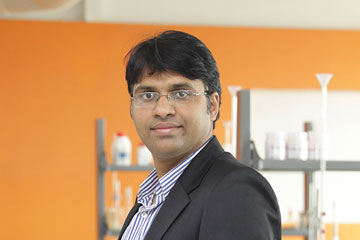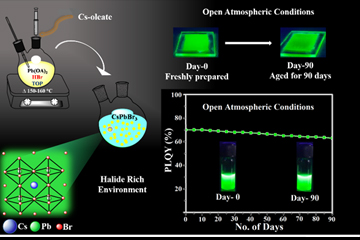Amine-free air- stable perovskite nanocrystals for future optoelectronic devices

Dr. Nimai Mishra, Department of Chemistry, SRM University-AP, Andhra Pradesh, along with his research group comprising of his Ph.D. students – Mr. Syed Akhil and Ms. V.G.Vasavi Dutt, have published “Completely Amine-free Open Atmospheric Synthesis of High Quality Cesium Lead Bromide (CsPbBr3) Perovskite Nanocrystals” in the journal “Chemistry-A European Journal” (Wiley-VCH, Impact factor 4.86).
Cesium Lead Halide Perovskite Nanocrystals (NCs) CsPbX3 (X=Cl, Br, and I) have gained popularity in the last few years due to their high Photoluminescence Quantum Yield (PLQY) owning for Light Emitting Diodes (LEDs), and other significant applications in Photovoltaic and Optoelectronics. Dr Mishra says, “In this research work, we demonstrated a facile and efficient amine- free synthesis of Cesium Lead Bromide Perovskite Nanocrystals using Hydrobromic acid as halide source and n-trioctylphosphine (TOP) as ligand in open atmospheric conditions.” He further explains, “The hydrobromic acid (HBr) served as labile source of bromide ion, thus, this three-precursor (separate precursors for Cs-Pb-Br) approach gives more control over conventional single-source precursor for Pb and Br (PbBr2). The use of HBr paved the way to eliminate oleylamine, as a result, we can completely exclude the formation of labile oleylammonium ion halide.”
 Dr Mishra and his research group extensively studied the various Cs-Pb-Br molar ratio and found an optimum condition that was able to stabilize with high PLQY CsPbBr3 NCs. These completely amine-free CsPbBr3 perovskite NCs synthesized using bromine-rich condition, exhibit good stability and durability for more than three months in the form of colloidal solutions and films respectively. Furthermore, they demonstrated stable tunable emission across a wide spectral range, via anion exchange process. More significantly, their work presents an open atmospheric stable CsPbBr3 NCs films demonstrating high photoluminescence (PL), which can be further used for optoelectronic device applications.
Dr Mishra and his research group extensively studied the various Cs-Pb-Br molar ratio and found an optimum condition that was able to stabilize with high PLQY CsPbBr3 NCs. These completely amine-free CsPbBr3 perovskite NCs synthesized using bromine-rich condition, exhibit good stability and durability for more than three months in the form of colloidal solutions and films respectively. Furthermore, they demonstrated stable tunable emission across a wide spectral range, via anion exchange process. More significantly, their work presents an open atmospheric stable CsPbBr3 NCs films demonstrating high photoluminescence (PL), which can be further used for optoelectronic device applications.
These high-quality nanocrystals have the potential to be used as active material in LED devices. Advancing his research, Dr Mishra and his team are planning to make a prototype LED device using their nanocrystals.
Link to the research paper: Please Click Here

